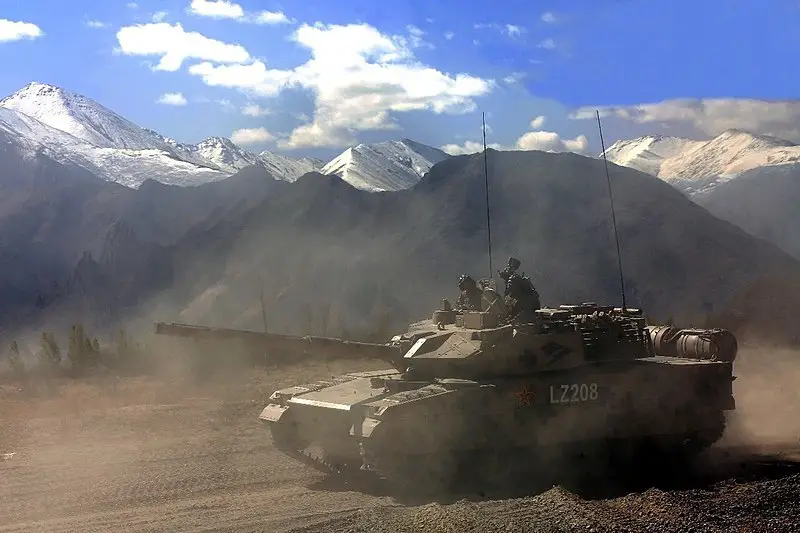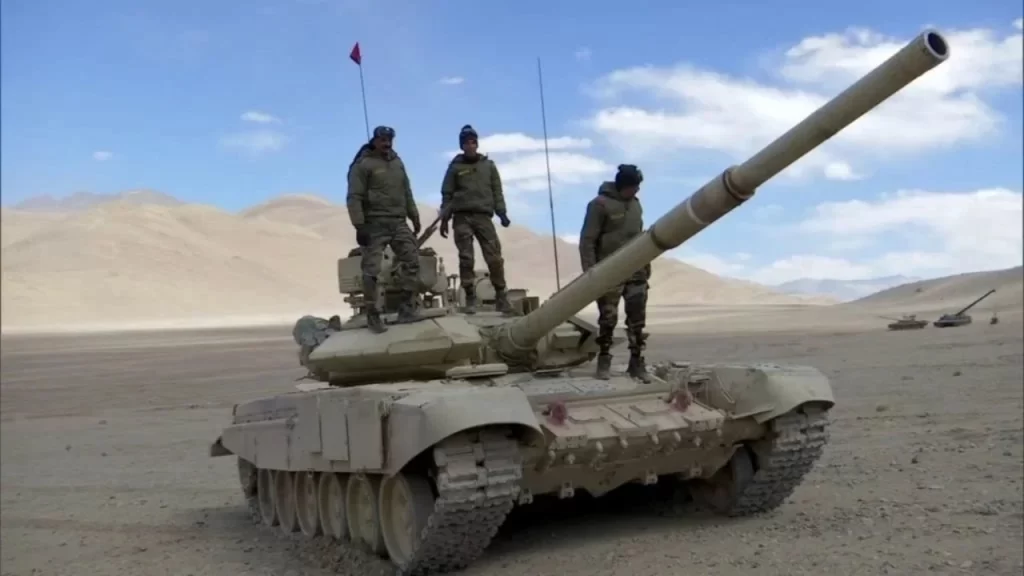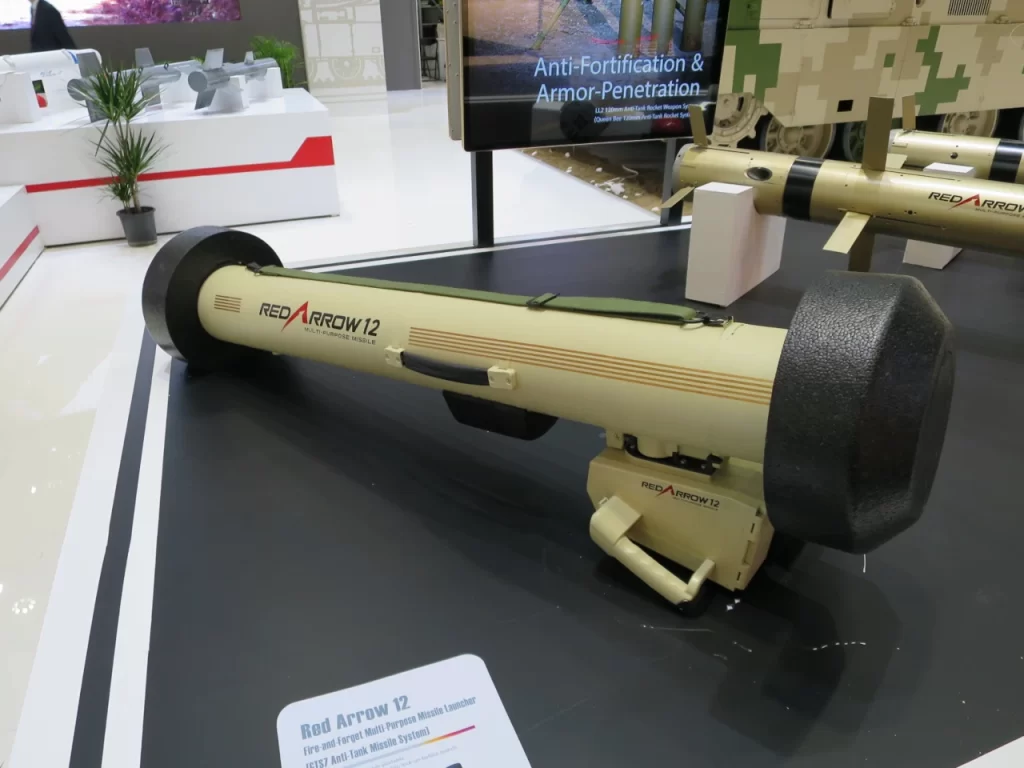Armoured units of the Chinese Peoples’ Liberation Army (PLA) have significantly improved their operational effectiveness in mountainous terrains at high altitudes by deploying Type-15 light tanks (ZTQ-15) in the Western Theater Command, which controls the Xinjiang and Xizang (Tibet) Military Regions. The deployment of Type-15 tanks, in conjunction with ZTZ-88 or Type-88 and Type 99A tanks, has been seen along the border with India.
The 30-ton class Type 15 tank prioritises its operational and tactical flexibility and situational capabilities over its firepower and protection. This contrasts with the main battle tanks.
The Type 15 tank can efficiently engage and destroy various other armoured vehicles since it has a ‘105mm rifled tank gun.’ Additionally, the Type 15 tank is able to survive attacks from a variety of anti-tank missiles and rocket launchers because of its ‘reactive armour.’. According to reports, the effective shooting range of the primary cannon is three kilometres, and it is compatible with all regular NATO 105 mm tank ammunition. It reportedly can destroy contemporary frontal armour and fire anti-tank missiles directed by lasers. It is known that the missile has a maximum range of 5,200 metres (5.2 kilometres) and can penetrate armour that is 700 mm thick.

The Type 15 tank was explicitly optimised for operating in high-altitude environments, but a complex terrain with hills and valleys marks the intricate topography of such places. The Type 15 tank demonstrates limited effectiveness in traversing uneven terrain but does well in flat landscapes. In contrast, infantry units retain their pivotal role as the primary combat force when confronted with steep inclines and mountainous regions.

On the Indian border, Chinese infantry must contend with sophisticated main battle tanks such as the T-90S Bhishma and T-72M1. Using the Thales Optronique-manufactured CATHERINE-FC thermal camera, the T-90S’s ESSA thermal imaging sight enables accurate firing at ranges between 5,000 and 8,000 meters (5 to 8 kilometres) during the day and 3,300 metres (3 kilometres) at night. The 125mm smoothbore cannon can fire 8 kilometre laser-guided missiles during the day and night. The T-90MS version deployed suits the arid, chilly climates of Ladakh, Sikkim, and Arunachal Pradesh in the far north and east. The Indian heavy tanks are not expected to move into Chinese territory and hence have a lesser issue with the terrain. In a few years from now, the Indian Army too will be equipped with a superior 30 ton light tank under Project Zorawar.
The People’s Liberation Army of the People’s Republic of China (PLA) cannot provide any assurance that its tanks will be able to arrive immediately on all fronts that require tank help. If Chinese forces embark on an assault and come up against Indian forces armed with the above mentioned main battle tanks, the efficacy of Chinese Type 15 tanks is likely to be questioned. The innate anti-tank firepower that the infantry possesses will become an important component in determining the outcome of such a battle.
The PLA’s Western Theatre Command has made public the most recent training images of frontline troops and disclosed that a composite brigade of the Xinjiang Military Region has been provided with the Red Arrow-12 anti-tank missile. It suggests that the most cutting-edge anti-tank missile ever developed by China has been stationed at the already tense border between China and India.

As per the open source, the fire-and-forget feature of the man portable Red Arrow-12 (NORINCO HJ-12 ) anti-tank missile differentiates it from the Red Arrow-73 (NORINCO HJ-73) anti-tank missile currently used by the PLA. Red Arrow-12 can independently calculate the distance between its operator and the desired target, after which it sends this information to the missile’s fire control system. The embedded computer system calculates the missile’s trajectory when the launch is initiated. This trajectory is generated using the available data, which enables the missile to fly along a course characterised by significant elevation, finally directing it towards the target intended for it. After this, the sensor on the missile will undertake an autonomous search for the target tank, and once it has located it, it will engage it by aiming for the vulnerable top armour of the tank. Its body has a diameter of 140 millimetres, and its warhead is a tandem-shaped charge capable of penetrating at least 1000 mm of homogenous steel armour. According to reports in Chinese media, the anti-tank missile of the third generation allegedly possesses robust anti-interference capabilities. The highest range achieved with the TV version is four kilometres. However, the maximum range achieved with the IR variant is just two kilometres.
For confronting Chinese tank forces, India has multiple types of anti-tank guided missiles (ATGMs). India uses Israeli Infrared Guided Spike MR Man portable ATGM with a maximum range of 2.5 kilometres.
The Chinese have deployed an anti-tank guided missile (ATGM) called the Red Arrow-10, which has a range of 10 km. The Indian third-generation fire-and-forget Nag ATGM, comparable to the Chinese version, has also been deployed. The Nag is a top-attack missile with a maximum range of up to seven kilometres.
The Chinese helicopter gunships are not as well suited to high-altitude missions as their Indian counterparts. The Chinese helicopters also have difficulty taking off with a full load in the terrain. The Indian helicopter gunships are capable of using anti-tank guided missiles. The maximum range of the helicopter-launched Helina (SANT) ATGM is between 15 and 20 km. It is quite doubtful that top armour of type 15 can withstand these ATGMs. The conflict in Russia has shown that T-90 tanks resist ATGMs in most situations, even those involving top attacks.
